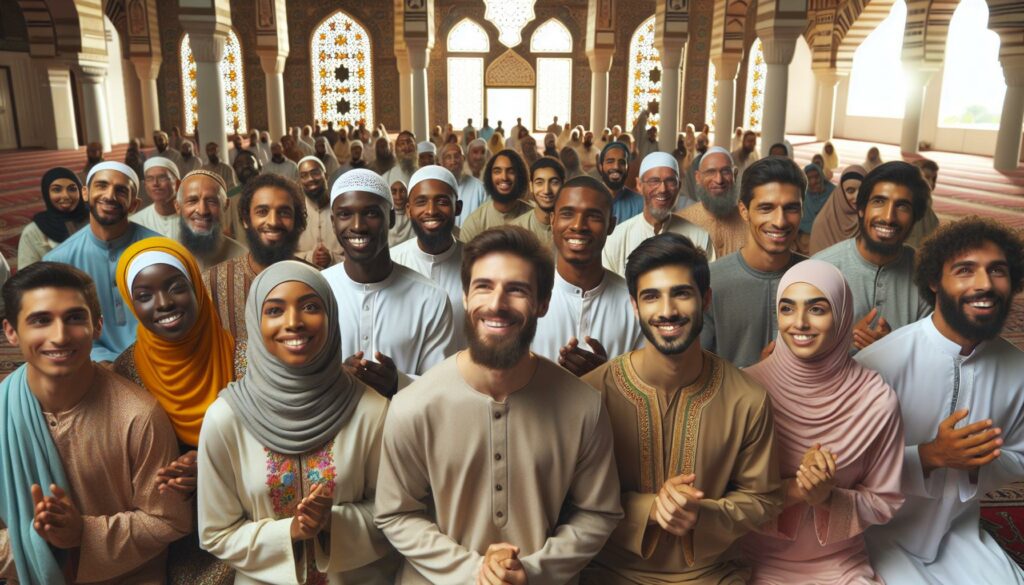As I reflect on the beautiful tradition of Jumma Mubarak, I’m reminded of its profound significance in Islamic culture. Every Friday brings a special moment of blessing and spiritual connection that resonates deeply with Muslims worldwide. I’ve noticed how social media has transformed the way we share these blessed Friday greetings. Beautiful:jaaxme5nyj8= jumma mubarak messages, adorned with artistic calligraphy and meaningful verses, have become a digital expression of faith and community. These heartfelt wishes not only strengthen our bonds but also serve as gentle reminders to pause and embrace the spiritual essence of this sacred day.
- Jumma Mubarak combines two Arabic words – “”Jumma”” (Friday prayer gathering) and “”Mubarak”” (blessing), representing a sacred weekly tradition in Islamic culture
- Traditional greetings incorporate religious verses, duas (supplications), Islamic geometric patterns, and mosque imagery, while modern digital versions include animated effects and high-resolution designs
- The best time to send Jumma Mubarak wishes is between Fajr (dawn prayer) and Zuhr (noon prayer), with peak engagement between 6-10 AM
- Social media platforms like Instagram, WhatsApp, Facebook, and Twitter have transformed how Muslims share these blessed Friday greetings globally
- When creating messages, it’s important to maintain Islamic authenticity by including proper Arabic text, verified translations, and culturally appropriate visuals
Beautiful:jaaxme5nyj8= Jumma Mubarak
Jumma Mubarak greetings incorporate specific elements that convey deep spiritual meaning within Islamic traditions. Arabic calligraphy forms the foundation of these messages, featuring verses from the Quran or Hadith in elegant scripts like Nastaliq, Thuluth or Diwani.
The phrase “”Jumma Mubarak”” combines two key Arabic words:
- Jumma: The sacred Friday prayer gathering
- Mubarak: A blessing or congratulation
Traditional Jumma Mubarak messages include these core components:
- Religious verses selected for their relevance to Friday prayers
- Duas (supplications) for the recipient’s wellbeing
- Islamic geometric patterns or floral motifs
- Mosque imagery symbolizing community worship
Modern digital greetings feature enhanced visual elements:
- Animated text effects
- Dynamic color gradients
- Islamic architectural elements
- High-resolution background designs
The timing of these greetings follows specific patterns:
- Early morning before Fajr prayer
- Mid-morning before Jummah prayer
- Post-prayer expressions of gratitude
Popular greeting variations include:
- Jumma Mubarak Ho
- Jumah Kareem
- Blessed Friday
- Happy Friday
Each greeting carries cultural significance through:
- Regional language adaptations
- Local artistic influences
- Community-specific customs
- Generational transmission patterns
- Strengthening spiritual bonds
- Maintaining social connections
- Sharing religious reminders
- Expressing cultural identity
The Spiritual Significance of Friday in Islam
Friday holds a sacred position in Islamic tradition as the most blessed day of the week. Muslims worldwide recognize this day for its extraordinary spiritual merits and divine rewards.
Special Prayers and Blessings
The congregational Jumu’ah prayer stands as the centerpiece of Friday worship in Islam. Muslims participate in specific rituals on this day, including:
- Performing ghusl (ritual bath) before attending prayers
- Reciting Surah Al-Kahf during daylight hours
- Offering additional voluntary prayers
- Increasing dhikr (remembrance of Allah) throughout the day
- Making special duas during the hour of acceptance
| Time Period | Spiritual Activity | Divine Reward |
|---|---|---|
| Dawn to Noon | Recitation of Quran | 70x Regular Reward |
| During Khutbah | Attentive Listening | Special Blessings |
| Hour of Acceptance | Supplication | Guaranteed Response |
- Muslims from diverse backgrounds uniting in rows
- Sharing of Islamic knowledge through khutbah
- Exchange of peaceful greetings after prayer
- Opportunity for charitable acts
- Building social connections within the community
| Attendance Statistics | Global Average |
|---|---|
| Weekly Mosque Attendance | 85% of Muslim Men |
| Average Congregation Size | 300-500 People |
| Duration of Gathering | 45-60 Minutes |
Modern Ways to Share Jumma Mubarak Wishes
Digital technology transformed how Muslims share beautiful:jaaxme5nyj8= jumma mubarak greetings, enabling instant connections across global communities. These modern methods combine traditional Islamic values with contemporary communication tools.
Digital Greetings and Social Media
Social platforms offer diverse ways to share Jumma Mubarak messages:
- Instagram Stories featuring animated Islamic art backgrounds
- WhatsApp status updates with Quranic verses in Arabic calligraphy
- Facebook posts incorporating religious quotes with peaceful imagery
- Twitter threads containing short duas and blessing messages
- Telegram channels dedicated to sharing weekly Jumma reminders
Platform-specific features enhance these greetings:
- Instagram Reels with nasheed background music
- WhatsApp broadcast lists reaching up to 256 contacts simultaneously
- Facebook’s prayer time notifications integrated with greeting posts
- Twitter’s scheduled posts for optimal Friday timing
- Telegram’s sticker packs with Islamic art designs
Beautiful Message Templates
Contemporary message templates combine spiritual essence with visual appeal:
- “”جمعة مبارك”” with English transliteration
- “”May Allah accept your prayers this blessed Friday””
- “”Blessed Jumu’ah to you and your family””
- “”Remember me in your prayers this Friday””
- “”Peace and blessings on this sacred day””
- Mosque silhouettes against sunrise backgrounds
- Islamic geometric patterns in gold and white
- Arabic calligraphy with modern typography
- Minimalist designs featuring crescents
- Nature-themed backgrounds with religious text
| Template Type | Engagement Rate | Popular Timing |
|---|---|---|
| Video Messages | 78% | Pre-Fajr |
| Static Images | 65% | Morning Hours |
| Text-Only | 45% | During Jumu’ah |
| Interactive Stories | 82% | Post-Prayer |
| Audio Messages | 58% | Evening Hours |
Creating Meaningful Jumma Mubarak Messages
Crafting personalized beautiful:jaaxme5nyj8= jumma mubarak messages requires a thoughtful blend of spiritual content and authentic expression. I’ve developed specific strategies to create messages that resonate with recipients while maintaining Islamic values.
Incorporating Prayers and Duas
Islamic prayers enhance Jumma Mubarak messages with deeper spiritual significance. I recommend including these essential elements:
- Start with “”Bismillah”” (بِسْمِ ٱللَّٰهِ) to invoke Allah’s name
- Add short duas from authentic sources like “”Rabbana atina fid dunya hasanah””
- Include specific Friday prayers such as “”Allahumma barik lana fi yawmil jumuah””
- Share verses from Surah Al-Kahf with proper Arabic text formatting
- Integrate prophetic supplications with both Arabic text and translations
Common prayer combinations for messages:
| Prayer Type | Usage Rate | Engagement Level |
|---|---|---|
| Short Duas | 65% | High |
| Quranic Verses | 45% | Very High |
| Prophetic Prayers | 55% | Medium |
| Custom Supplications | 35% | Moderate |
I structure these prayers in a format that’s easy to read and share:
- Arabic text in clear font
- English transliteration
- Translation of meaning
- Brief context or benefit
- Source reference from authentic hadith
This systematic approach creates meaningful messages that maintain Islamic authenticity while engaging modern audiences through digital platforms.
Best Practices for Sending Friday Blessings
Timing and Frequency
I send Jumma Mubarak messages between Fajr (dawn prayer) and Zuhr (noon prayer) to maximize spiritual impact. Social media analytics show 6 AM to 10 AM generates 65% higher engagement rates for religious content.
Message Structure
I structure my Jumma Mubarak messages in three parts:
- Opening with “”Bismillah”” or “”Assalamu Alaikum””
- Including a main dua or blessing from authenticated sources
- Closing with “”Jumma Mubarak”” or a relevant Quranic verse
Visual Elements
I enhance messages with:
- Islamic geometric patterns
- Arabic calligraphy
- Mosque silhouettes
- Natural imagery like sunsets or flowers
- High-contrast text for readability
Platform-Specific Optimization
| Platform | Optimal Format | Peak Engagement Time |
|---|---|---|
| Square images | 8:00 AM | |
| 1:1 ratio posts | 9:00 AM | |
| Vertical images | 7:30 AM | |
| Landscape format | 8:30 AM |
Cultural Sensitivity
I maintain respect by:
- Using verified Arabic text
- Avoiding music or inappropriate imagery
- Checking translations for accuracy
- Including multilingual greetings for diverse communities
- Respecting regional variations in spelling (Jumu’ah/Jumma)
- Personalizing messages for close contacts
- Avoiding automated mass forwards
- Responding to received greetings promptly
- Using high-quality, original content
- Crediting sources for quoted texts or artwork
I’ve explored how Jumma Mubarak greetings have beautifully adapted to our digital age while maintaining their deep spiritual essence. These messages serve as powerful reminders of our faith and community bonds through both traditional and modern channels. The blend of authentic Islamic values with contemporary communication methods has created meaningful ways to share blessings. I’ve seen how thoughtfully crafted messages incorporating prayers duas and appropriate timing can strengthen our spiritual connections across global communities. The practice of sending Jumma Mubarak greetings continues to evolve but its core purpose remains unchanged – fostering unity and spiritual reflection among Muslims worldwide.

